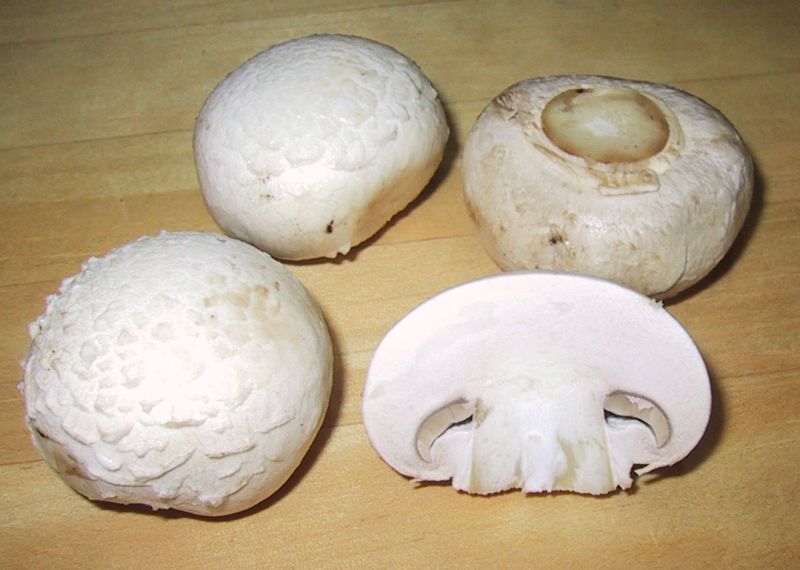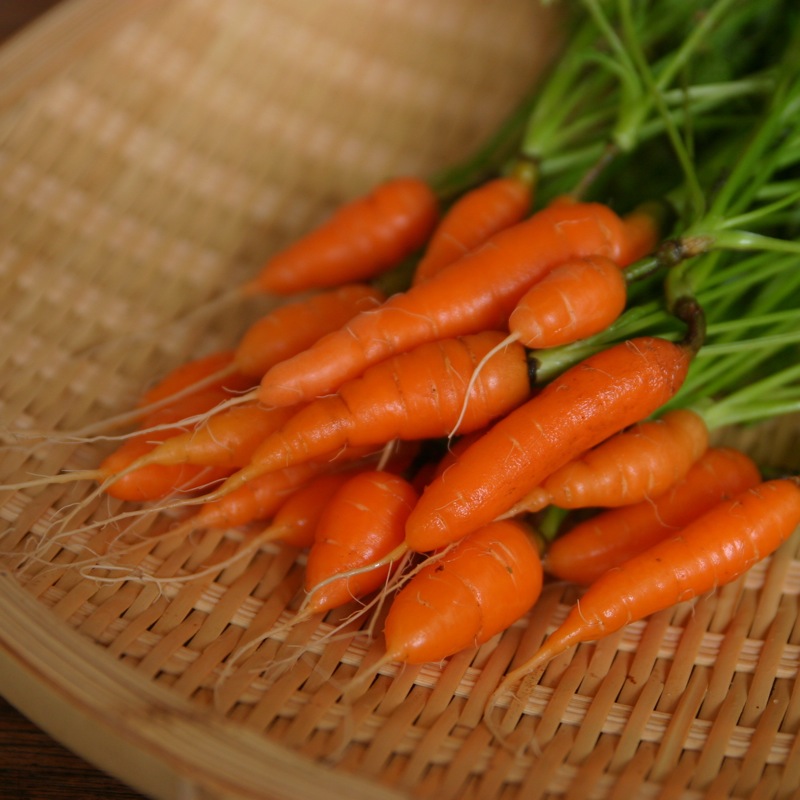Mushroom vs. Baby Carrots
Nutrition comparison of Mushroom and Baby Carrots
Ever wonder how your favorite foods stack up against each other in terms of nutrition?
We compared the nutritional contents of
mushroom
versus
baby carrots
(100g each)
below using 2020 USDA and NIH data[1].
For a quick recap of significant nutrients and differences in mushroom and baby carrots:
- Both baby carrots and mushroom are high in potassium.
- Baby carrot has signficantly more calcium than mushroom.
- Baby carrot is a great source of dietary fiber.
- Baby carrot is an excellent source of Vitamin A.
- Mushroom has more thiamin, riboflavin, niacin, pantothenic acid and Vitamin B12.
USDA sources for nutritional information: Mushroom (Mushrooms, white, raw) and Baby Carrots (Carrots, baby, raw) . Have a correction or suggestions? Shoot us an email.
Calories and Carbs
calories
Baby carrots and mushroom contain similar amounts of calories - baby carrot has 35 calories per 100 grams and mushroom has 22 calories.
For macronutrient ratios, mushroom is much heavier in protein, much lighter in carbs and heavier in fat compared to baby carrots per calorie. Mushroom has a macronutrient ratio of 43:43:14 and for baby carrots, 8:92:0 for protein, carbohydrates and fat from calories.
Macro Ratios from Calories:
| Mushroom | Baby Carrots | |
|---|---|---|
| Protein | 43% | 8% |
| Carbohydrates | 43% | 92% |
| Fat | 14% | ~ |
| Alcohol | ~ | ~ |
carbohydrates
Baby carrots and mushroom contain similar amounts of carbs - baby carrot has 8.2g of total carbs per 100 grams and mushroom has 3.3g of carbohydrates.
The carbs in baby carrots are made of 62% sugar and 38% dietary fiber, whereas the carbs in mushroom comprise of 66% sugar and 34% dietary fiber.
dietary fiber
Baby carrot is a great source of dietary fiber and it has 190% more dietary fiber than mushroom - baby carrot has 2.9g of dietary fiber per 100 grams and mushroom has 1g of dietary fiber.
sugar
Baby carrots and mushroom contain similar amounts of sugar - baby carrot has 4.8g of sugar per 100 grams and mushroom has 2g of sugar.
Protein
protein
Mushroom has 383% more protein than baby carrot - baby carrot has 0.64g of protein per 100 grams and mushroom has 3.1g of protein.
Fat
saturated fat
Both baby carrots and mushroom are low in saturated fat - baby carrot has 0.02g of saturated fat per 100 grams and mushroom has 0.05g of saturated fat.
Vitamins
Vitamin C
Baby carrots and mushroom contain similar amounts of Vitamin C - baby carrot has 2.6mg of Vitamin C per 100 grams and mushroom has 2.1mg of Vitamin C.
Vitamin A
Baby carrot is an excellent source of Vitamin A and it has more Vitamin A than mushroom - baby carrot has 690ug of Vitamin A per 100 grams and mushroom does not contain significant amounts.
Vitamin D
Mushroom has more Vitamin D than baby carrot - mushroom has 7iu of Vitamin D per 100 grams and baby carrot does not contain significant amounts.
Vitamin E
Mushroom and baby carrots contain similar amounts of Vitamin E - mushroom has 0.01mg of Vitamin E per 100 grams and baby carrot does not contain significant amounts.
Vitamin K
Baby carrot has more Vitamin K than mushroom - baby carrot has 9.4ug of Vitamin K per 100 grams and mushroom does not contain significant amounts.
The B Vitamins
Mushroom has more thiamin, riboflavin, niacin, pantothenic acid and Vitamin B12. Both mushroom and baby carrots contain significant amounts of Vitamin B6 and folate.
| Mushroom | Baby Carrots | |
|---|---|---|
| Thiamin | 0.081 MG | 0.03 MG |
| Riboflavin | 0.402 MG | 0.036 MG |
| Niacin | 3.607 MG | 0.556 MG |
| Pantothenic acid | 1.497 MG | 0.401 MG |
| Vitamin B6 | 0.104 MG | 0.105 MG |
| Folate | 17 UG | 27 UG |
| Vitamin B12 | 0.04 UG | ~ |
Minerals
calcium
Baby carrot has signficantly more calcium than mushroom - baby carrot has 32mg of calcium per 100 grams and mushroom has 3mg of calcium.
iron
Baby carrots and mushroom contain similar amounts of iron - baby carrot has 0.89mg of iron per 100 grams and mushroom has 0.5mg of iron.
potassium
Both baby carrots and mushroom are high in potassium. Mushroom has 34% more potassium than baby carrot - baby carrot has 237mg of potassium per 100 grams and mushroom has 318mg of potassium.
Omega-3 and Omega-6
omega 6s
Comparing omega-6 fatty acids, mushroom has more linoleic acid than baby carrot per 100 grams.
| Mushroom | Baby Carrots | |
|---|---|---|
| linoleic acid | 0.16 G | 0.057 G |
| Total | 0.16 G | 0.057 G |
Customize your serving size
The comparison below is by common portions, e.g. cups, packages. You can also see a more concrete comparison by weight at equal weight (by grams) comparison.
Note: The specific food items compared are: Mushroom (Mushrooms, white, raw) and Baby Carrots (Carrots, baby, raw) .
Mushroom g
()
|
Daily Values (%) |
Baby Carrots g
()
|
|||||
|---|---|---|---|---|---|---|---|
| KCAL % |
|
5% | calories | 5% |
|
KCAL % | |
| G % |
|
5% | carbohydrates | 5% |
|
G % | |
| G % |
|
5% | dietary fiber | 5% |
|
G % | |
| G | 5% | sugar | 5% | G | |||
| G % |
|
5% | total fat | 5% |
|
G % | |
| G % |
|
5% | saturated fat | 5% |
|
G % | |
| G | 5% | monounsaturated fat | 5% | G | |||
| G | 5% | polyunsaturated fat | 5% | G | |||
| G | 5% | trans fat | 5% | G | |||
| MG | 5% | cholesterol | 5% | MG | |||
| MG % |
|
5% | sodium | 5% |
|
MG % | |
| 5% | Vitamins and Minerals | 5% | |||||
| UG % |
|
5% | Vitamin A | 5% |
|
UG % | |
| MG % |
|
5% | Vitamin C | 5% |
|
MG % | |
| IU % |
|
5% | Vitamin D | 5% |
|
IU % | |
| MG % |
|
5% | calcium | 5% |
|
MG % | |
| MG % |
|
5% | iron | 5% |
|
MG % | |
| MG % |
|
5% | magnesium | 5% |
|
MG % | |
| MG % |
|
5% | potassium | 5% |
|
MG % | |
| MG % |
|
5% | thiamin (Vit B1) | 5% |
|
MG % | |
| MG % |
|
5% | riboflavin (Vit B2) | 5% |
|
MG % | |
| MG % |
|
5% | niacin (Vit B3) | 5% |
|
MG % | |
| MG % |
|
5% | Vitamin B6 | 5% |
|
MG % | |
| MG % |
|
5% | pantothenic acid (Vit B5) | 5% |
|
MG % | |
| UG % |
|
5% | folate (Vit B9) | 5% |
|
UG % | |
| UG % |
|
5% | Vitamin B12 | 5% |
|
UG % | |
| MG % |
|
5% | Vitamin E | 5% |
|
MG % | |
| UG % |
|
5% | Vitamin K | 5% |
|
UG % | |
| G % |
|
5% | protein | 5% |
|
G % | |
| UG % |
|
5% | biotin (Vit B7) | 5% |
|
UG % | |
| MG % |
|
5% | choline | 5% |
|
MG % | |
| MG % |
|
5% | chlorine | 5% |
|
MG % | |
| UG % |
|
5% | chromium | 5% |
|
UG % | |
| MG % |
|
5% | copper | 5% |
|
MG % | |
| UG % |
|
5% | fluoride | 5% |
|
UG % | |
| UG % |
|
5% | iodine | 5% |
|
UG % | |
| MG % |
|
5% | manganese | 5% |
|
MG % | |
| UG % |
|
5% | molybdenum | 5% |
|
UG % | |
| MG % |
|
5% | phosphorus | 5% |
|
MG % | |
| UG % |
|
5% | selenium | 5% |
|
UG % | |
| MG % |
|
5% | zinc | 5% |
|
MG % | |
| G | 5% | Water | 5% | G | |||
| G | 5% | Starch | 5% | G | |||
| G | 5% | Alcohol | 5% | G | |||
FAQ
Does baby carrots or mushroom contain more calories in 100 grams?Baby carrots and mushroom contain similar amounts of calories - baby carrot has 35 calories in 100g and mushroom has 22 calories.
Is baby carrots or mushroom better for protein?
Mushroom has 380% more protein than baby carrot - baby carrot has 0.64g of protein per 100 grams and mushroom has 3.1g of protein.
Does baby carrots or mushroom have more carbohydrates?
By weight, baby carrots and mushroom contain similar amounts of carbs - baby carrot has 8.2g of carbs for 100g and mushroom has 3.3g of carbohydrates. the carbs in baby carrots are made of 60% sugar and 40% dietary fiber, whereas the carbs in mushroom comprise of 70% sugar and 30% dietary fiber.
Does baby carrots or mushroom contain more potassium?
Both baby carrots and mushroom are high in potassium. Mushroom has 30% more potassium than baby carrot - baby carrot has 237mg of potassium in 100 grams and mushroom has 318mg of potassium.

